Unilever: Human Relations, Organisational Structure and Culture Report
VerifiedAdded on 2023/01/10
|13
|2947
|20
Report
AI Summary
This report provides a comprehensive analysis of Unilever, a multinational consumer goods company. It begins with a company background, highlighting Unilever's global presence and diverse product portfolio. The first task is an essay advocating for the implementation of the human relations management model, emphasizing its benefits for employee motivation, communication, and conflict resolution, supported by a case study of Tesco. The second task presents a report detailing Unilever's organisational structure, comparing functional, divisional, and matrix structures, with a recommendation for the matrix structure. It also examines Charles Handy's model of organisational culture, differentiating between power, role, task, and person cultures. The report concludes with a discussion on how these factors impact Unilever's operational productivity and overall business performance.
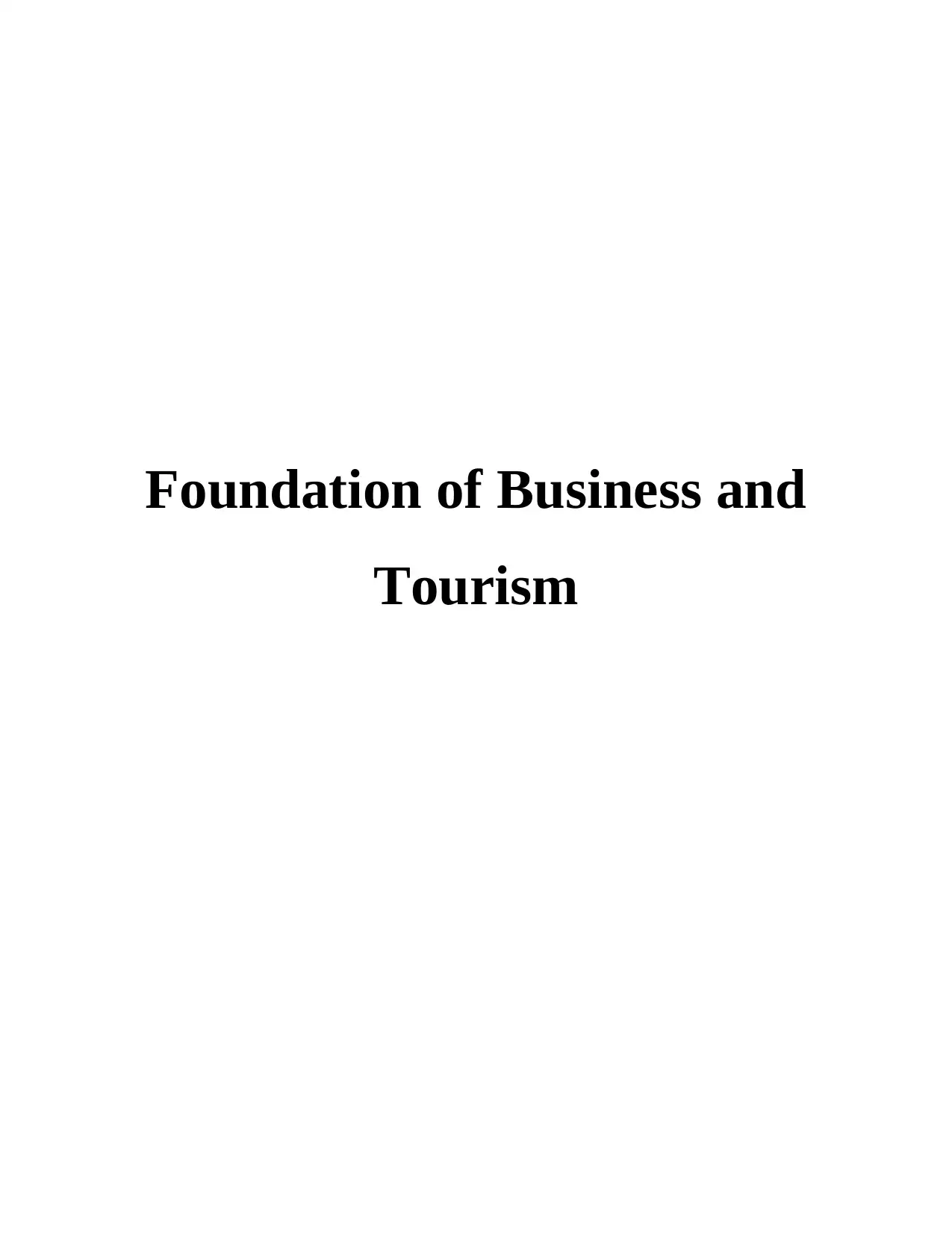
Foundation of Business and
Tourism
Tourism
Paraphrase This Document
Need a fresh take? Get an instant paraphrase of this document with our AI Paraphraser
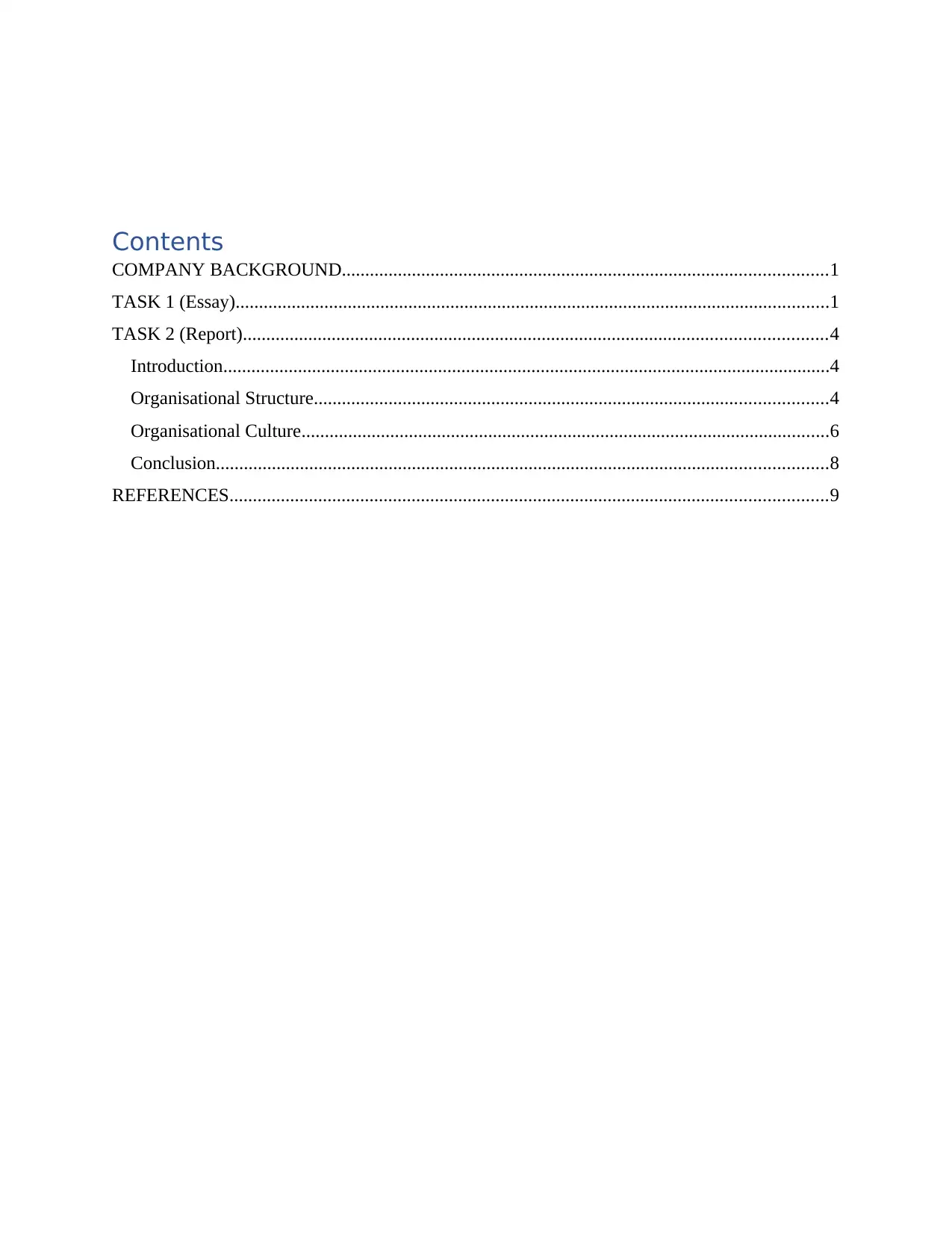
Contents
COMPANY BACKGROUND........................................................................................................1
TASK 1 (Essay)...............................................................................................................................1
TASK 2 (Report).............................................................................................................................4
Introduction..................................................................................................................................4
Organisational Structure..............................................................................................................4
Organisational Culture.................................................................................................................6
Conclusion...................................................................................................................................8
REFERENCES................................................................................................................................9
COMPANY BACKGROUND........................................................................................................1
TASK 1 (Essay)...............................................................................................................................1
TASK 2 (Report).............................................................................................................................4
Introduction..................................................................................................................................4
Organisational Structure..............................................................................................................4
Organisational Culture.................................................................................................................6
Conclusion...................................................................................................................................8
REFERENCES................................................................................................................................9

⊘ This is a preview!⊘
Do you want full access?
Subscribe today to unlock all pages.

Trusted by 1+ million students worldwide

COMPANY BACKGROUND
Unilever is a public sector organisation dealing in consumer goods such as food products,
beauty products or personal care products. Company was founded in the year 1929 and the
headquarters of the company are located at London, United Kingdom. Unilever sells its products
in more than 190 countries all over the world and is a high volume public sector organisation.
Company is listed on the London Stock Exchange and owns more than 400 different brands.
Unilever is also the largest producer of soap in the world (Jansen, 2018).
TASK 1 (Essay)
Management Model
Management Model can be defined as the choices or decisions made by the management
of an organisation with respect to defining vision and objectives, creating shared values,
motivating employees, coordination efforts and organising and allocating resources (Ansoff and
et. al., 2018). Management model primarily guides the managers on how to execute the functions
of management. Operations and effectiveness of an organisation in achieving the objectives is
largely influenced by the management style and approach in the company (Spring, Johnes and
Hald, 2017). There are various models and theories which can be implemented by managers of a
business organisation to administer the business activities of the company. The management of
Unilever is recommended to implement the human relations model of management in their
organisation for maximisation of operational as well as financial performance and productivity.
Human Relations Model of Management:
Human Relations Approach of Management originated from a series of experiments
which were conducted by Elton Mayo and his associates at the Western Electric Company’s
Hawthorne Works. According to this model, management in an organisation is primarily
concerned with understanding and comprehending the behaviour of employees in an organisation
(Mulder, 2019). Important interrelation between the productivity of an employee and the
interpersonal relationships in an organisation was determined with the help of this model
contrary to the prior belief of management which stated that employee productivity in an
organisation is a function of physical working environment and the compensation being
provided. It was concluded on the basis of experiments conducted by Elton Mayo that employee
productivity is largely dependent on employee relations in the organisation. It has also been
1
Unilever is a public sector organisation dealing in consumer goods such as food products,
beauty products or personal care products. Company was founded in the year 1929 and the
headquarters of the company are located at London, United Kingdom. Unilever sells its products
in more than 190 countries all over the world and is a high volume public sector organisation.
Company is listed on the London Stock Exchange and owns more than 400 different brands.
Unilever is also the largest producer of soap in the world (Jansen, 2018).
TASK 1 (Essay)
Management Model
Management Model can be defined as the choices or decisions made by the management
of an organisation with respect to defining vision and objectives, creating shared values,
motivating employees, coordination efforts and organising and allocating resources (Ansoff and
et. al., 2018). Management model primarily guides the managers on how to execute the functions
of management. Operations and effectiveness of an organisation in achieving the objectives is
largely influenced by the management style and approach in the company (Spring, Johnes and
Hald, 2017). There are various models and theories which can be implemented by managers of a
business organisation to administer the business activities of the company. The management of
Unilever is recommended to implement the human relations model of management in their
organisation for maximisation of operational as well as financial performance and productivity.
Human Relations Model of Management:
Human Relations Approach of Management originated from a series of experiments
which were conducted by Elton Mayo and his associates at the Western Electric Company’s
Hawthorne Works. According to this model, management in an organisation is primarily
concerned with understanding and comprehending the behaviour of employees in an organisation
(Mulder, 2019). Important interrelation between the productivity of an employee and the
interpersonal relationships in an organisation was determined with the help of this model
contrary to the prior belief of management which stated that employee productivity in an
organisation is a function of physical working environment and the compensation being
provided. It was concluded on the basis of experiments conducted by Elton Mayo that employee
productivity is largely dependent on employee relations in the organisation. It has also been
1
Paraphrase This Document
Need a fresh take? Get an instant paraphrase of this document with our AI Paraphraser

concluded that employees in an organisation exhibit behaviour as a part of group rather than
individuals (King, 2016). The management of Unilever can implement this model in their
organisation by demonstrating important skills of human relations which are being mentioned
below:
Communication: For implementing human relations management model, effective and
fluent communication between the members of organisation and management is an essential
element. Leaders of Unilever should be able to demonstrate effective communication skills
which includes empathetic behaviour to understand the needs of employees (Drossman, 2019).
Multitasking: Multitasking abilities of the management of Unilever will help in coordinating
various aspects of human relations management model which involves aspects such as maintain
performance of employees and at the same time, encouraging employees to increase engagement
in the training and development campaigns.
Conflict Resolution: In the context of Unilever, a vast team of employees from diverse and
distinct backgrounds has to be managed effectively to maintain operational productivity.
Conflicts are expected to arise quite frequently but the management should be able to manage
and resolve these conflicts in the best manner and ensure that it doesn’t impact the overall
productivity of the company (Gossman, Ellis and Toney-Butler, 2019).
Organisation: Organising is the most important managerial skills which involves
arrangement of physical and other organisational resources in the most optimum manner to
increase productivity and mitigate wastage in the company. It is vital for management of
Unilever to organise physical work space in the best manner possible.
Justification:
Human relations management model will be the most suitable management model
considering the organisational requirements and needs of Unilever. Company operates in many
countries all over the world and to maintain competitive edge, it is important for the management
to foster and build a motivated workforce. On the basis of this model, it has been observed that
employee productivity is dependent on employee motivation and personal relations of the
employees in a company. With the help of cultivating positive work relationships and providing
a team environment to the employees with high prospects of future growth and success,
workforce of the company can be motivated which will naturally increase the operational
productivity (Bendix and Fisher, 2017). Most significant argument in favour of Human Relations
2
individuals (King, 2016). The management of Unilever can implement this model in their
organisation by demonstrating important skills of human relations which are being mentioned
below:
Communication: For implementing human relations management model, effective and
fluent communication between the members of organisation and management is an essential
element. Leaders of Unilever should be able to demonstrate effective communication skills
which includes empathetic behaviour to understand the needs of employees (Drossman, 2019).
Multitasking: Multitasking abilities of the management of Unilever will help in coordinating
various aspects of human relations management model which involves aspects such as maintain
performance of employees and at the same time, encouraging employees to increase engagement
in the training and development campaigns.
Conflict Resolution: In the context of Unilever, a vast team of employees from diverse and
distinct backgrounds has to be managed effectively to maintain operational productivity.
Conflicts are expected to arise quite frequently but the management should be able to manage
and resolve these conflicts in the best manner and ensure that it doesn’t impact the overall
productivity of the company (Gossman, Ellis and Toney-Butler, 2019).
Organisation: Organising is the most important managerial skills which involves
arrangement of physical and other organisational resources in the most optimum manner to
increase productivity and mitigate wastage in the company. It is vital for management of
Unilever to organise physical work space in the best manner possible.
Justification:
Human relations management model will be the most suitable management model
considering the organisational requirements and needs of Unilever. Company operates in many
countries all over the world and to maintain competitive edge, it is important for the management
to foster and build a motivated workforce. On the basis of this model, it has been observed that
employee productivity is dependent on employee motivation and personal relations of the
employees in a company. With the help of cultivating positive work relationships and providing
a team environment to the employees with high prospects of future growth and success,
workforce of the company can be motivated which will naturally increase the operational
productivity (Bendix and Fisher, 2017). Most significant argument in favour of Human Relations
2
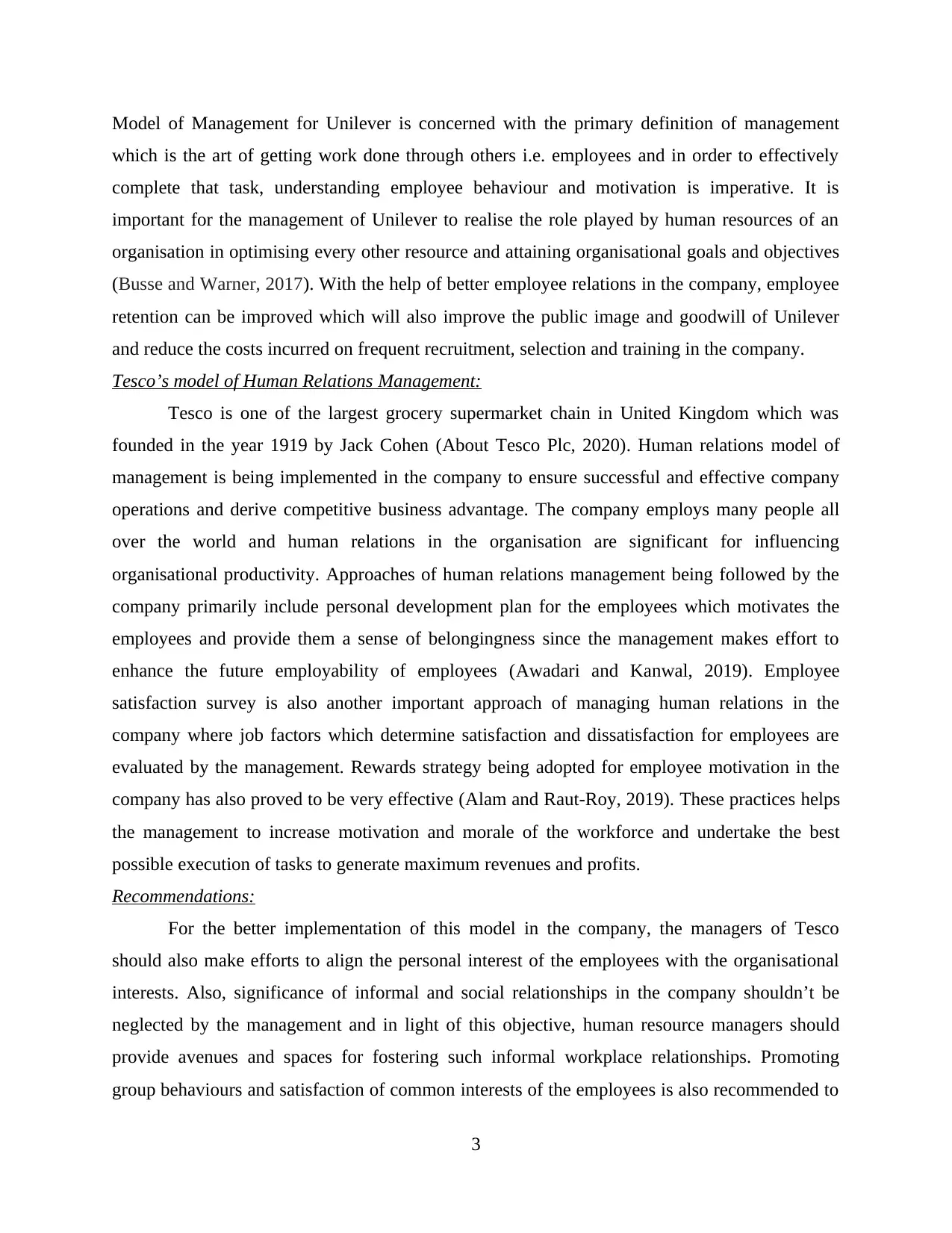
Model of Management for Unilever is concerned with the primary definition of management
which is the art of getting work done through others i.e. employees and in order to effectively
complete that task, understanding employee behaviour and motivation is imperative. It is
important for the management of Unilever to realise the role played by human resources of an
organisation in optimising every other resource and attaining organisational goals and objectives
(Busse and Warner, 2017). With the help of better employee relations in the company, employee
retention can be improved which will also improve the public image and goodwill of Unilever
and reduce the costs incurred on frequent recruitment, selection and training in the company.
Tesco’s model of Human Relations Management:
Tesco is one of the largest grocery supermarket chain in United Kingdom which was
founded in the year 1919 by Jack Cohen (About Tesco Plc, 2020). Human relations model of
management is being implemented in the company to ensure successful and effective company
operations and derive competitive business advantage. The company employs many people all
over the world and human relations in the organisation are significant for influencing
organisational productivity. Approaches of human relations management being followed by the
company primarily include personal development plan for the employees which motivates the
employees and provide them a sense of belongingness since the management makes effort to
enhance the future employability of employees (Awadari and Kanwal, 2019). Employee
satisfaction survey is also another important approach of managing human relations in the
company where job factors which determine satisfaction and dissatisfaction for employees are
evaluated by the management. Rewards strategy being adopted for employee motivation in the
company has also proved to be very effective (Alam and Raut-Roy, 2019). These practices helps
the management to increase motivation and morale of the workforce and undertake the best
possible execution of tasks to generate maximum revenues and profits.
Recommendations:
For the better implementation of this model in the company, the managers of Tesco
should also make efforts to align the personal interest of the employees with the organisational
interests. Also, significance of informal and social relationships in the company shouldn’t be
neglected by the management and in light of this objective, human resource managers should
provide avenues and spaces for fostering such informal workplace relationships. Promoting
group behaviours and satisfaction of common interests of the employees is also recommended to
3
which is the art of getting work done through others i.e. employees and in order to effectively
complete that task, understanding employee behaviour and motivation is imperative. It is
important for the management of Unilever to realise the role played by human resources of an
organisation in optimising every other resource and attaining organisational goals and objectives
(Busse and Warner, 2017). With the help of better employee relations in the company, employee
retention can be improved which will also improve the public image and goodwill of Unilever
and reduce the costs incurred on frequent recruitment, selection and training in the company.
Tesco’s model of Human Relations Management:
Tesco is one of the largest grocery supermarket chain in United Kingdom which was
founded in the year 1919 by Jack Cohen (About Tesco Plc, 2020). Human relations model of
management is being implemented in the company to ensure successful and effective company
operations and derive competitive business advantage. The company employs many people all
over the world and human relations in the organisation are significant for influencing
organisational productivity. Approaches of human relations management being followed by the
company primarily include personal development plan for the employees which motivates the
employees and provide them a sense of belongingness since the management makes effort to
enhance the future employability of employees (Awadari and Kanwal, 2019). Employee
satisfaction survey is also another important approach of managing human relations in the
company where job factors which determine satisfaction and dissatisfaction for employees are
evaluated by the management. Rewards strategy being adopted for employee motivation in the
company has also proved to be very effective (Alam and Raut-Roy, 2019). These practices helps
the management to increase motivation and morale of the workforce and undertake the best
possible execution of tasks to generate maximum revenues and profits.
Recommendations:
For the better implementation of this model in the company, the managers of Tesco
should also make efforts to align the personal interest of the employees with the organisational
interests. Also, significance of informal and social relationships in the company shouldn’t be
neglected by the management and in light of this objective, human resource managers should
provide avenues and spaces for fostering such informal workplace relationships. Promoting
group behaviours and satisfaction of common interests of the employees is also recommended to
3
⊘ This is a preview!⊘
Do you want full access?
Subscribe today to unlock all pages.

Trusted by 1+ million students worldwide
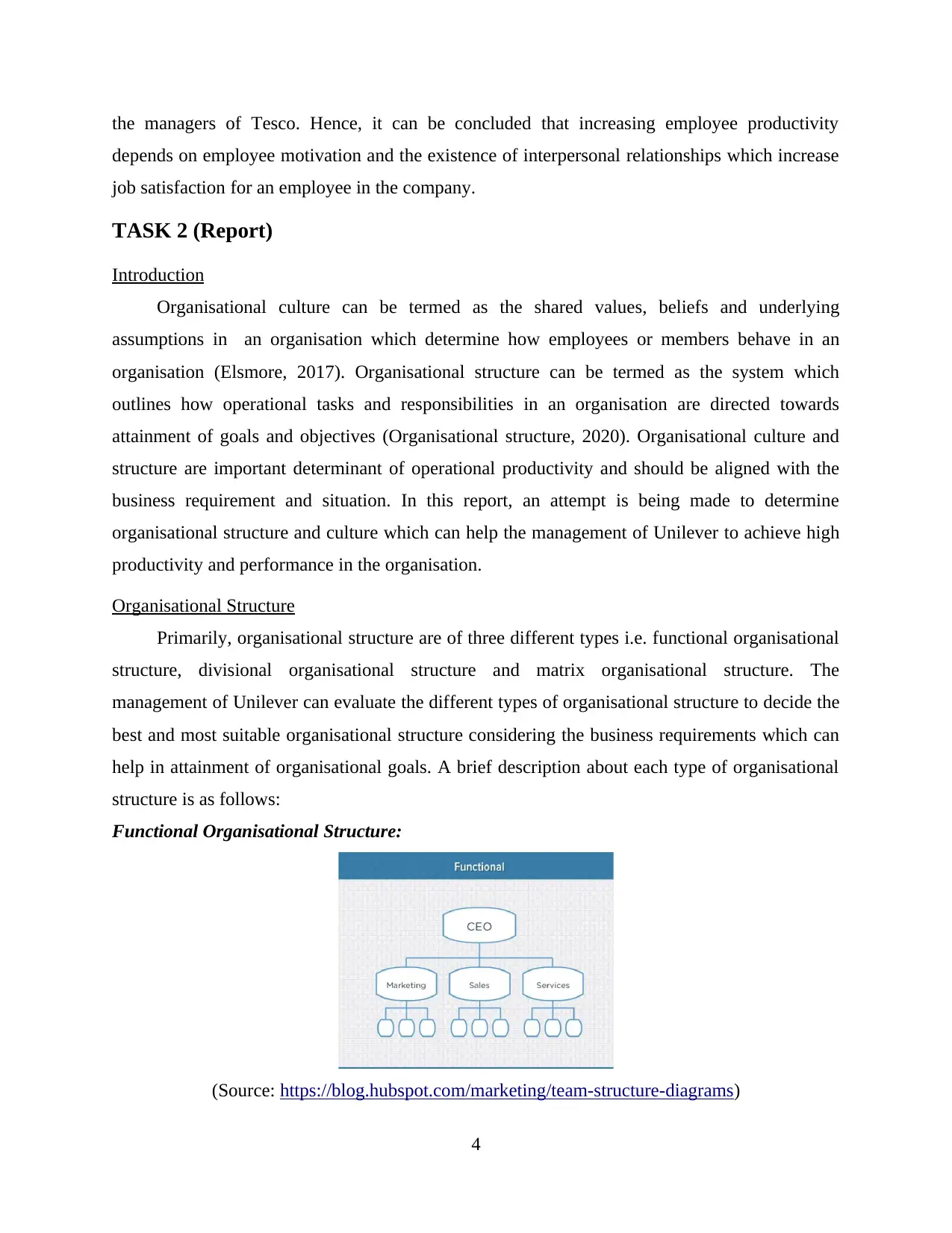
the managers of Tesco. Hence, it can be concluded that increasing employee productivity
depends on employee motivation and the existence of interpersonal relationships which increase
job satisfaction for an employee in the company.
TASK 2 (Report)
Introduction
Organisational culture can be termed as the shared values, beliefs and underlying
assumptions in an organisation which determine how employees or members behave in an
organisation (Elsmore, 2017). Organisational structure can be termed as the system which
outlines how operational tasks and responsibilities in an organisation are directed towards
attainment of goals and objectives (Organisational structure, 2020). Organisational culture and
structure are important determinant of operational productivity and should be aligned with the
business requirement and situation. In this report, an attempt is being made to determine
organisational structure and culture which can help the management of Unilever to achieve high
productivity and performance in the organisation.
Organisational Structure
Primarily, organisational structure are of three different types i.e. functional organisational
structure, divisional organisational structure and matrix organisational structure. The
management of Unilever can evaluate the different types of organisational structure to decide the
best and most suitable organisational structure considering the business requirements which can
help in attainment of organisational goals. A brief description about each type of organisational
structure is as follows:
Functional Organisational Structure:
(Source: https://blog.hubspot.com/marketing/team-structure-diagrams)
4
depends on employee motivation and the existence of interpersonal relationships which increase
job satisfaction for an employee in the company.
TASK 2 (Report)
Introduction
Organisational culture can be termed as the shared values, beliefs and underlying
assumptions in an organisation which determine how employees or members behave in an
organisation (Elsmore, 2017). Organisational structure can be termed as the system which
outlines how operational tasks and responsibilities in an organisation are directed towards
attainment of goals and objectives (Organisational structure, 2020). Organisational culture and
structure are important determinant of operational productivity and should be aligned with the
business requirement and situation. In this report, an attempt is being made to determine
organisational structure and culture which can help the management of Unilever to achieve high
productivity and performance in the organisation.
Organisational Structure
Primarily, organisational structure are of three different types i.e. functional organisational
structure, divisional organisational structure and matrix organisational structure. The
management of Unilever can evaluate the different types of organisational structure to decide the
best and most suitable organisational structure considering the business requirements which can
help in attainment of organisational goals. A brief description about each type of organisational
structure is as follows:
Functional Organisational Structure:
(Source: https://blog.hubspot.com/marketing/team-structure-diagrams)
4
Paraphrase This Document
Need a fresh take? Get an instant paraphrase of this document with our AI Paraphraser

It is the most common type of organisational structure under which, people who do
similar jobs and tasks are grouped together on the basis of their speciality. For example, all the
employees who are related with sales tasks will be grouped under the sales department and
similarly, employee working in finance will be grouped under the finance department (Types of
organisational structure, 2020). Every department has a superior who is usually an expert of the
subject matter for that particular department. This organisational structure enables quick
decision-making and employees are able to learn from their peers by observing due to similar
task and job roles.
Divisional Organisational Structure:
(Source: https://blog.hubspot.com/marketing/team-structure-diagrams)
Under divisional organisational structure, an organisation is formed on the basis of
multiple smaller and diverse functional structures. This type of structure is most suitable for
organisations with multiple horizontal divisions where complete autonomy can be provided to a
division to operate as a separate company with centralised supervision. Divisional organisational
structure can be based on different aspects such as product-divisional structure or market-
divisional structure (Types of organisational structure, 2020). It provides flexibility to different
divisions in an organisation but it may restrict the ability of workers with similar task working in
different division to communicate effectively with each other.
Matrix Organisational Structure:
5
similar jobs and tasks are grouped together on the basis of their speciality. For example, all the
employees who are related with sales tasks will be grouped under the sales department and
similarly, employee working in finance will be grouped under the finance department (Types of
organisational structure, 2020). Every department has a superior who is usually an expert of the
subject matter for that particular department. This organisational structure enables quick
decision-making and employees are able to learn from their peers by observing due to similar
task and job roles.
Divisional Organisational Structure:
(Source: https://blog.hubspot.com/marketing/team-structure-diagrams)
Under divisional organisational structure, an organisation is formed on the basis of
multiple smaller and diverse functional structures. This type of structure is most suitable for
organisations with multiple horizontal divisions where complete autonomy can be provided to a
division to operate as a separate company with centralised supervision. Divisional organisational
structure can be based on different aspects such as product-divisional structure or market-
divisional structure (Types of organisational structure, 2020). It provides flexibility to different
divisions in an organisation but it may restrict the ability of workers with similar task working in
different division to communicate effectively with each other.
Matrix Organisational Structure:
5
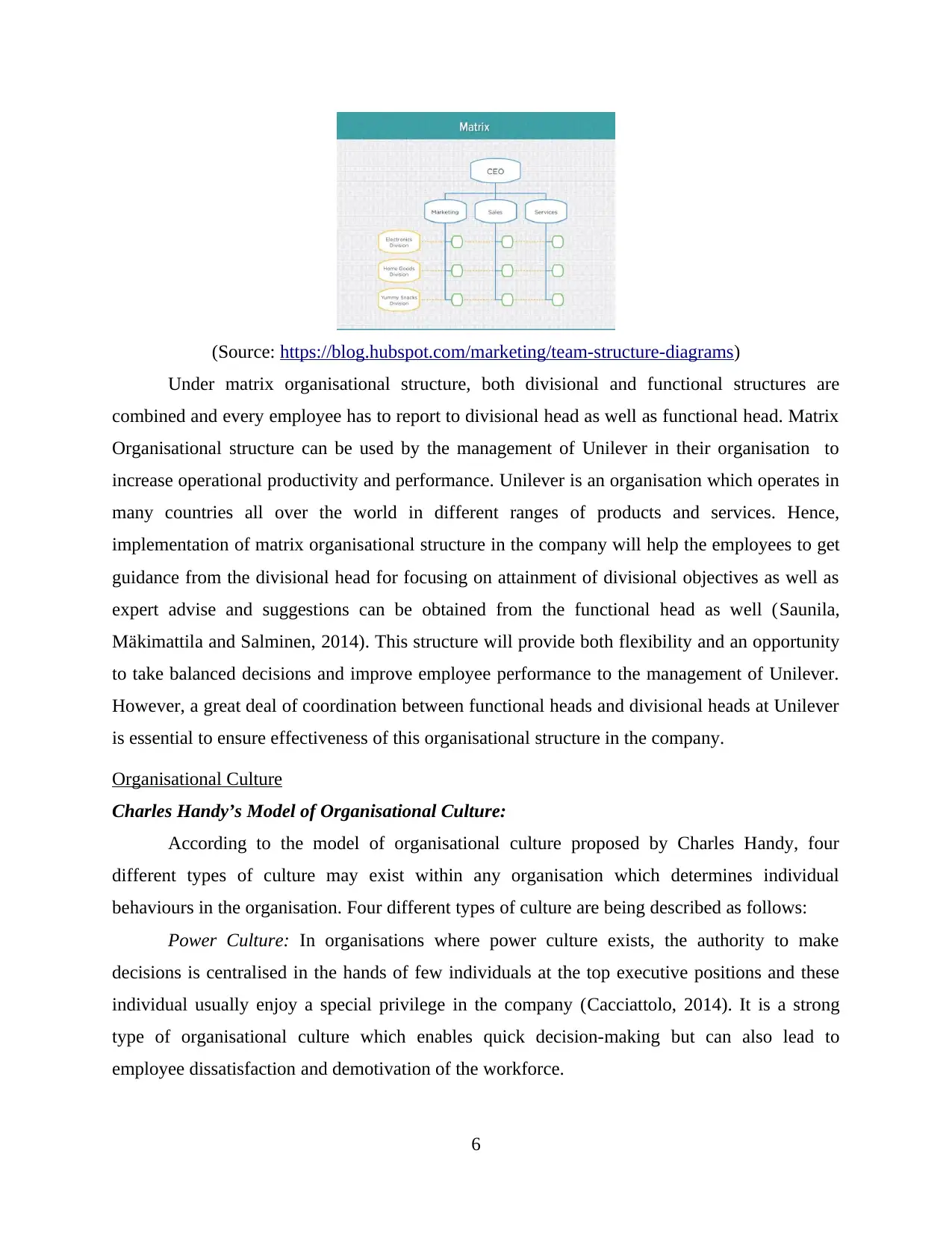
(Source: https://blog.hubspot.com/marketing/team-structure-diagrams)
Under matrix organisational structure, both divisional and functional structures are
combined and every employee has to report to divisional head as well as functional head. Matrix
Organisational structure can be used by the management of Unilever in their organisation to
increase operational productivity and performance. Unilever is an organisation which operates in
many countries all over the world in different ranges of products and services. Hence,
implementation of matrix organisational structure in the company will help the employees to get
guidance from the divisional head for focusing on attainment of divisional objectives as well as
expert advise and suggestions can be obtained from the functional head as well (Saunila,
Mäkimattila and Salminen, 2014). This structure will provide both flexibility and an opportunity
to take balanced decisions and improve employee performance to the management of Unilever.
However, a great deal of coordination between functional heads and divisional heads at Unilever
is essential to ensure effectiveness of this organisational structure in the company.
Organisational Culture
Charles Handy’s Model of Organisational Culture:
According to the model of organisational culture proposed by Charles Handy, four
different types of culture may exist within any organisation which determines individual
behaviours in the organisation. Four different types of culture are being described as follows:
Power Culture: In organisations where power culture exists, the authority to make
decisions is centralised in the hands of few individuals at the top executive positions and these
individual usually enjoy a special privilege in the company (Cacciattolo, 2014). It is a strong
type of organisational culture which enables quick decision-making but can also lead to
employee dissatisfaction and demotivation of the workforce.
6
Under matrix organisational structure, both divisional and functional structures are
combined and every employee has to report to divisional head as well as functional head. Matrix
Organisational structure can be used by the management of Unilever in their organisation to
increase operational productivity and performance. Unilever is an organisation which operates in
many countries all over the world in different ranges of products and services. Hence,
implementation of matrix organisational structure in the company will help the employees to get
guidance from the divisional head for focusing on attainment of divisional objectives as well as
expert advise and suggestions can be obtained from the functional head as well (Saunila,
Mäkimattila and Salminen, 2014). This structure will provide both flexibility and an opportunity
to take balanced decisions and improve employee performance to the management of Unilever.
However, a great deal of coordination between functional heads and divisional heads at Unilever
is essential to ensure effectiveness of this organisational structure in the company.
Organisational Culture
Charles Handy’s Model of Organisational Culture:
According to the model of organisational culture proposed by Charles Handy, four
different types of culture may exist within any organisation which determines individual
behaviours in the organisation. Four different types of culture are being described as follows:
Power Culture: In organisations where power culture exists, the authority to make
decisions is centralised in the hands of few individuals at the top executive positions and these
individual usually enjoy a special privilege in the company (Cacciattolo, 2014). It is a strong
type of organisational culture which enables quick decision-making but can also lead to
employee dissatisfaction and demotivation of the workforce.
6
⊘ This is a preview!⊘
Do you want full access?
Subscribe today to unlock all pages.

Trusted by 1+ million students worldwide

Role Culture: Under role culture, every member or employee of the company is aware
about his roles and responsibilities and power arises from the position of an individual in the
company. High bureaucracy and long chain of command are the common elements of
organisation with role culture which hampers the effectiveness of decision-making in some
situations (Handy, 2011).
Task Culture: Under task culture, teams are formed with an objective of solving specific
problems or completing a task based on the right match of skills and qualities. Power arises from
the individual expertise and knowledge of team members.
Person Culture: Under power culture, individuals in the organisation consider themselves
to be superior than the organisation and personal interest receive more attention over the
organisational interest which affects the productivity of the company in an adverse manner.
(Source: https://www.tutor2u.net/business/reference/models-of-organisational-culture-
handy)
On the basis of above discussion, it can be determined that management of Unilever
should implement task culture in the organisation. Unilever operates in a high competitive
environment where employee motivation and engagement is essential to foster creativity and
derive competitive edge. Under task culture, employees of the company derive power based on
their knowledge and expertise which improves the problem-solving ability of the team. It also
leads to employee motivation with a desire to get authority and power by improving knowledge
and expertise (Milne, 2007). The management of Unilever can ensure high productivity in the
organisation by implementing task culture and forming teams on the basis of right match of skills
and qualities which will also foster innovation and creativity in the company. Another significant
7
about his roles and responsibilities and power arises from the position of an individual in the
company. High bureaucracy and long chain of command are the common elements of
organisation with role culture which hampers the effectiveness of decision-making in some
situations (Handy, 2011).
Task Culture: Under task culture, teams are formed with an objective of solving specific
problems or completing a task based on the right match of skills and qualities. Power arises from
the individual expertise and knowledge of team members.
Person Culture: Under power culture, individuals in the organisation consider themselves
to be superior than the organisation and personal interest receive more attention over the
organisational interest which affects the productivity of the company in an adverse manner.
(Source: https://www.tutor2u.net/business/reference/models-of-organisational-culture-
handy)
On the basis of above discussion, it can be determined that management of Unilever
should implement task culture in the organisation. Unilever operates in a high competitive
environment where employee motivation and engagement is essential to foster creativity and
derive competitive edge. Under task culture, employees of the company derive power based on
their knowledge and expertise which improves the problem-solving ability of the team. It also
leads to employee motivation with a desire to get authority and power by improving knowledge
and expertise (Milne, 2007). The management of Unilever can ensure high productivity in the
organisation by implementing task culture and forming teams on the basis of right match of skills
and qualities which will also foster innovation and creativity in the company. Another significant
7
Paraphrase This Document
Need a fresh take? Get an instant paraphrase of this document with our AI Paraphraser
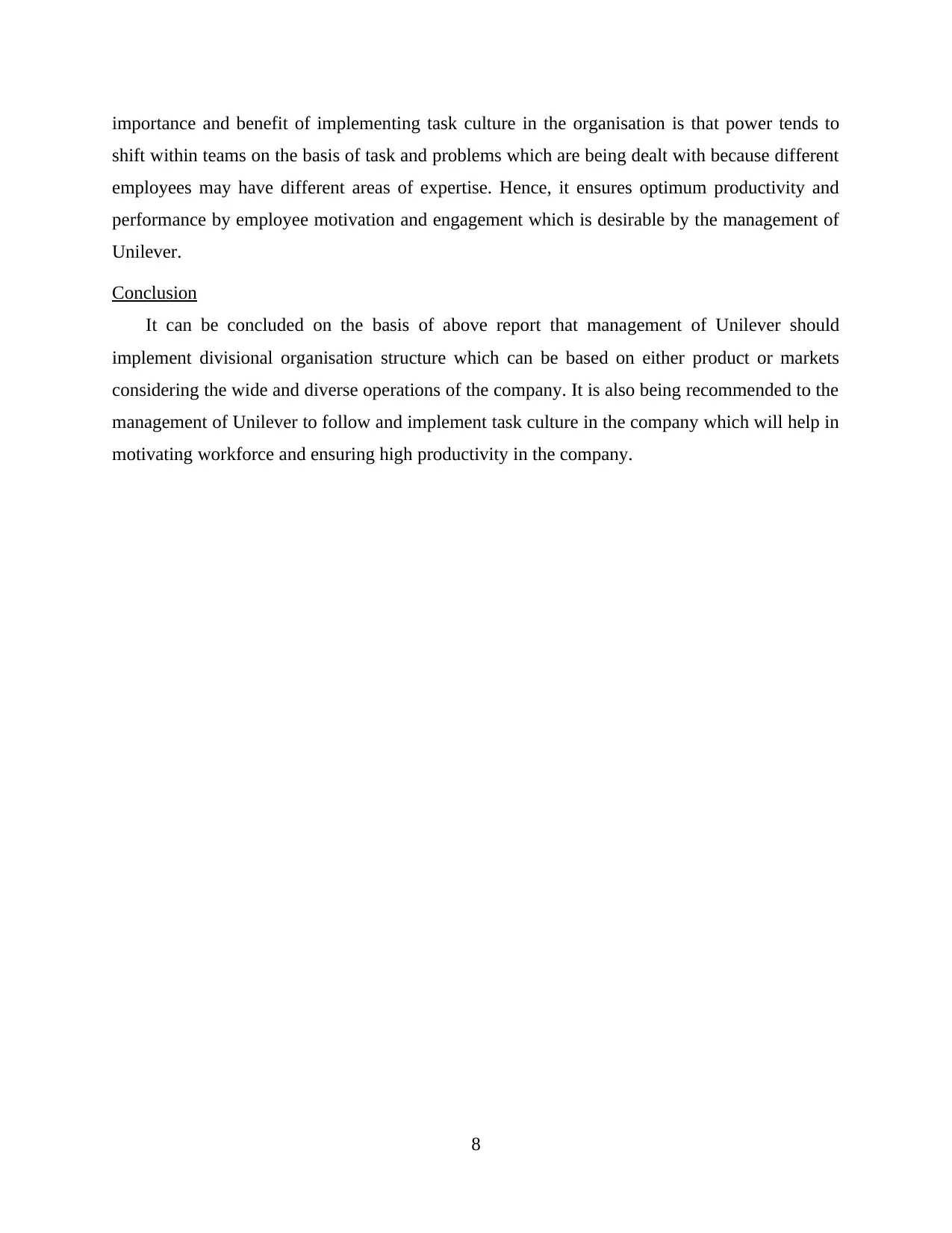
importance and benefit of implementing task culture in the organisation is that power tends to
shift within teams on the basis of task and problems which are being dealt with because different
employees may have different areas of expertise. Hence, it ensures optimum productivity and
performance by employee motivation and engagement which is desirable by the management of
Unilever.
Conclusion
It can be concluded on the basis of above report that management of Unilever should
implement divisional organisation structure which can be based on either product or markets
considering the wide and diverse operations of the company. It is also being recommended to the
management of Unilever to follow and implement task culture in the company which will help in
motivating workforce and ensuring high productivity in the company.
8
shift within teams on the basis of task and problems which are being dealt with because different
employees may have different areas of expertise. Hence, it ensures optimum productivity and
performance by employee motivation and engagement which is desirable by the management of
Unilever.
Conclusion
It can be concluded on the basis of above report that management of Unilever should
implement divisional organisation structure which can be based on either product or markets
considering the wide and diverse operations of the company. It is also being recommended to the
management of Unilever to follow and implement task culture in the company which will help in
motivating workforce and ensuring high productivity in the company.
8

REFERENCES
Books and Journals
Alam, S. and Raut-Roy, U., 2019. Evaluating the Effectiveness of Reward Strategy at Tesco:
Evidence from Selected Stores in UK. Indian Journal of Industrial Relations. 55(1).
Ansoff, H.I., Kipley, D., Lewis, A.O., Helm-Stevens, R. and Ansoff, R., 2018. Implanting
strategic management. Springer.
Awadari, A.C. and Kanwal, S., 2019. Employee participation in organizational change: A case of
Tesco PLC. International Journal of Financial, Accounting, and Management. 1(2).
pp.91-99.
Bendix, R. and Fisher, L.H., 2017. The perspectives of Elton Mayo. In The Anthropology of
Organisations (pp. 11-18). Routledge.
Busse, R. and Warner, M., 2017. The legacy of the hawthorne experiments: A critical analysis of
the human relations school of though. History of Economic Ideas. 25(2). pp.91-114.
Cacciattolo, K., 2014. Understanding organisational cultures. European scientific journal. 2(1).
pp.1-7.
Drossman, D.A., 2019. COMMUNICATION SKILLS.
Elsmore, P., 2017. Organisational Culture: Organisational Change?: Organisational Change?.
Routledge.
Gossman, W., Ellis, V.L. and Toney-Butler, T.J., 2019. Conflict Management.
Handy, C., 2011. Beyond Certainty: the changing worlds of organisations. Random House.
Jansen, K., 2018. Unilever–Sustainable Living Plan. Retrieved May, 2.
King, D., 2016. Human relations movement/Mayo. In Encyclopedia of Human Resource
Management. Edward Elgar Publishing Limited.
Milne, P., 2007. Motivation, incentives and organisational culture. Journal of knowledge
management.
Mulder, P., 2019. Human Relations Theory by Elton Mayo.
Saunila, M., Mäkimattila, M. and Salminen, J., 2014. Matrix structure for supporting
organisational innovation capability. International Journal of Business Innovation and
Research. 8(1). pp.20-35.
Spring, M., Johnes, G. and Hald, K.S., 2017. Productivity: Multi-disciplinary Perspectives for
Policy and Management.
Online
Organisational structure. 2020. [Online]. Available
thru<https://www.investopedia.com/terms/o/organizational-structure.asp>
Types of organisational structure. 2020. [Online]. Available
thru<https://www.investopedia.com/terms/o/organizational-structure.asp>
About Tesco Plc. 2020. [Online]. Available
thru<https://www.bloomberg.com/profile/company/TSCO:LN>
9
Books and Journals
Alam, S. and Raut-Roy, U., 2019. Evaluating the Effectiveness of Reward Strategy at Tesco:
Evidence from Selected Stores in UK. Indian Journal of Industrial Relations. 55(1).
Ansoff, H.I., Kipley, D., Lewis, A.O., Helm-Stevens, R. and Ansoff, R., 2018. Implanting
strategic management. Springer.
Awadari, A.C. and Kanwal, S., 2019. Employee participation in organizational change: A case of
Tesco PLC. International Journal of Financial, Accounting, and Management. 1(2).
pp.91-99.
Bendix, R. and Fisher, L.H., 2017. The perspectives of Elton Mayo. In The Anthropology of
Organisations (pp. 11-18). Routledge.
Busse, R. and Warner, M., 2017. The legacy of the hawthorne experiments: A critical analysis of
the human relations school of though. History of Economic Ideas. 25(2). pp.91-114.
Cacciattolo, K., 2014. Understanding organisational cultures. European scientific journal. 2(1).
pp.1-7.
Drossman, D.A., 2019. COMMUNICATION SKILLS.
Elsmore, P., 2017. Organisational Culture: Organisational Change?: Organisational Change?.
Routledge.
Gossman, W., Ellis, V.L. and Toney-Butler, T.J., 2019. Conflict Management.
Handy, C., 2011. Beyond Certainty: the changing worlds of organisations. Random House.
Jansen, K., 2018. Unilever–Sustainable Living Plan. Retrieved May, 2.
King, D., 2016. Human relations movement/Mayo. In Encyclopedia of Human Resource
Management. Edward Elgar Publishing Limited.
Milne, P., 2007. Motivation, incentives and organisational culture. Journal of knowledge
management.
Mulder, P., 2019. Human Relations Theory by Elton Mayo.
Saunila, M., Mäkimattila, M. and Salminen, J., 2014. Matrix structure for supporting
organisational innovation capability. International Journal of Business Innovation and
Research. 8(1). pp.20-35.
Spring, M., Johnes, G. and Hald, K.S., 2017. Productivity: Multi-disciplinary Perspectives for
Policy and Management.
Online
Organisational structure. 2020. [Online]. Available
thru<https://www.investopedia.com/terms/o/organizational-structure.asp>
Types of organisational structure. 2020. [Online]. Available
thru<https://www.investopedia.com/terms/o/organizational-structure.asp>
About Tesco Plc. 2020. [Online]. Available
thru<https://www.bloomberg.com/profile/company/TSCO:LN>
9
⊘ This is a preview!⊘
Do you want full access?
Subscribe today to unlock all pages.

Trusted by 1+ million students worldwide
1 out of 13
Related Documents
Your All-in-One AI-Powered Toolkit for Academic Success.
+13062052269
info@desklib.com
Available 24*7 on WhatsApp / Email
![[object Object]](/_next/static/media/star-bottom.7253800d.svg)
Unlock your academic potential
Copyright © 2020–2025 A2Z Services. All Rights Reserved. Developed and managed by ZUCOL.




